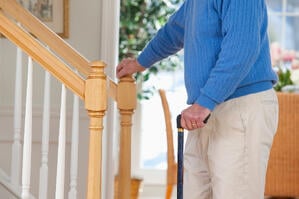4 Tips for Preventing Falls in Your Home
Anneliese Peterson | Jan 19, 2015
We all like to think of ourselves as an independent person. From a young age, we are encouraged to be strong and independent. As adults age, it is difficult to give up that independence and accept help. Adult children often struggle with respecting their parent’s independence, while also ensuring their safety and health when living at home alone.
Older adults are often reluctant to give up their independence – which is understandable. However, falls in the home pose a significant health risk to older adults. According to the US Centers for Disease Control (CDC), thousands of American seniors fall in the home and experience severe injury and even death in the process. An additional 1.5 million older adults are treated in emergency rooms because of falls.
With the help of the following tips, you can respect the independent spirit of your aging parents or loved ones, while preparing them and their home to avoid falls.
1: Assess Danger Areas
 The first of many tips for preventing falls is analyzing the layout of the home and identifying the potential danger areas. According to the National Safety Council, falls are the second leading type of unintentional home-related injuries and deaths. Falls commonly occur in the following areas:
The first of many tips for preventing falls is analyzing the layout of the home and identifying the potential danger areas. According to the National Safety Council, falls are the second leading type of unintentional home-related injuries and deaths. Falls commonly occur in the following areas:
- Doorways
- Ramps
- Ladders
- Stairs
- Areas with uneven surfaces
A simple walk through your home can help identify some trouble spots that can be easy to eliminate. Look at the floors in each room and see if furniture can be rearranged to make clear pathways, and remove floor rugs that pose a tripping hazard. When it comes to stairways, make sure each step is sturdy and even, keep the steps clear of any objects (shoes, clothes, etc.), and make sure there is proper lighting in the stairway.
2: Be Mindful of Physical Abilities and Limitations
Obstacles and dangers in the home are not the only cause of falls in the home. Preventing falls can also be done through an analysis of physical abilities and limitations. The Mayo Clinic suggests making an appointment with a healthcare provider or doctor to examine the impact of current medications and ensure that existing health conditions don’t contribute to falls.
The Mayo Clinic points out that some prescription and over-the-counter medications, as well as supplements, can bring about side effects that increase the risk of falling. Sedatives and antidepressants, for example, have been identified as possible contributors to falls in the home. Only a doctor can assess the interactions these drugs have with one’s body and the threat they pose to falls.
Preventing falls in the home is also possible through proactive approaches. Working to remain physically active offers positive results in preventing falls. By walking, participating in water exercise classes, or even taking yoga, an older adult can improve strength, balance, and coordination. All of those factors can help avoid falls.
If you fear that a parent or loved one is more likely to fall during physical activity, consult with their doctor. A doctor might be able to recommend an exercise program that is specially designed for seniors and is carefully monitored to ensure safety.
3: Be Sensible in the Home
Older adults should always choose wisely when putting on shoes or other footwear in the home. Shoes with heals, floppy slippers, slick heels, and socks increase the likelihood that a person could lose their balance and fall. Encourage the use of proper fitting shoes with nonskid soles, especially if your home has tile, hardwood floor, or other smooth surfaces.
4: Invest in Assistive Devices
Last but not least, don’t be afraid to invest in assistive devices that allow older adults to maintain independence while also preventing falls. Doctors can recommend the use of a cane or walker to provide added stability, but there are other devices available too. Examples of common devices include:
- Hand rails on both sides of stairways
- Nonslip treads on slippery surfaces
- Raised toilet seats with armrests
- Grab bars in showers/tubs
- Sturdy plastic seats in shower/tub
- Install stair lifts if necessary
By following these simple tips, you can prepare your senior parent to continue living in their own home, while preventing falls that pose a risk to their health and can result in death in a worst-case scenario.

